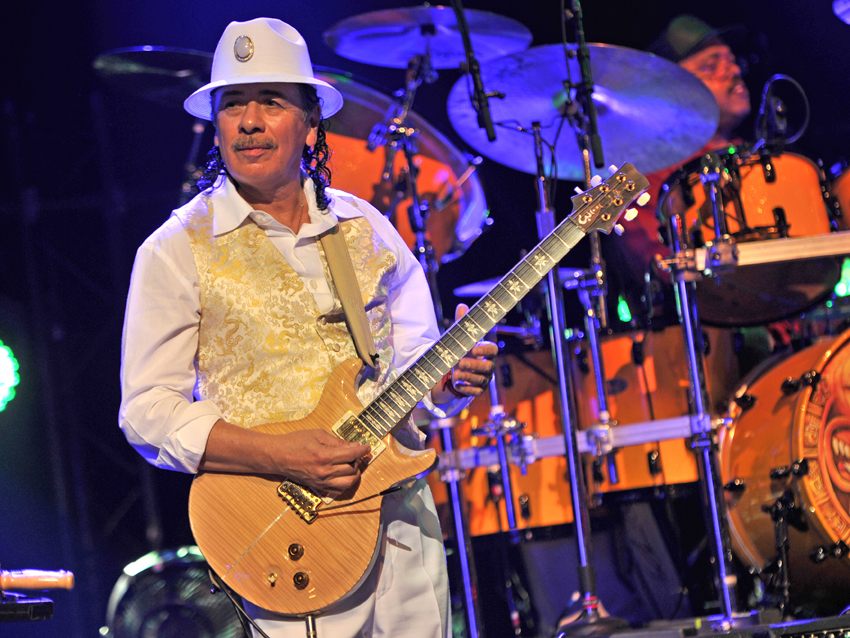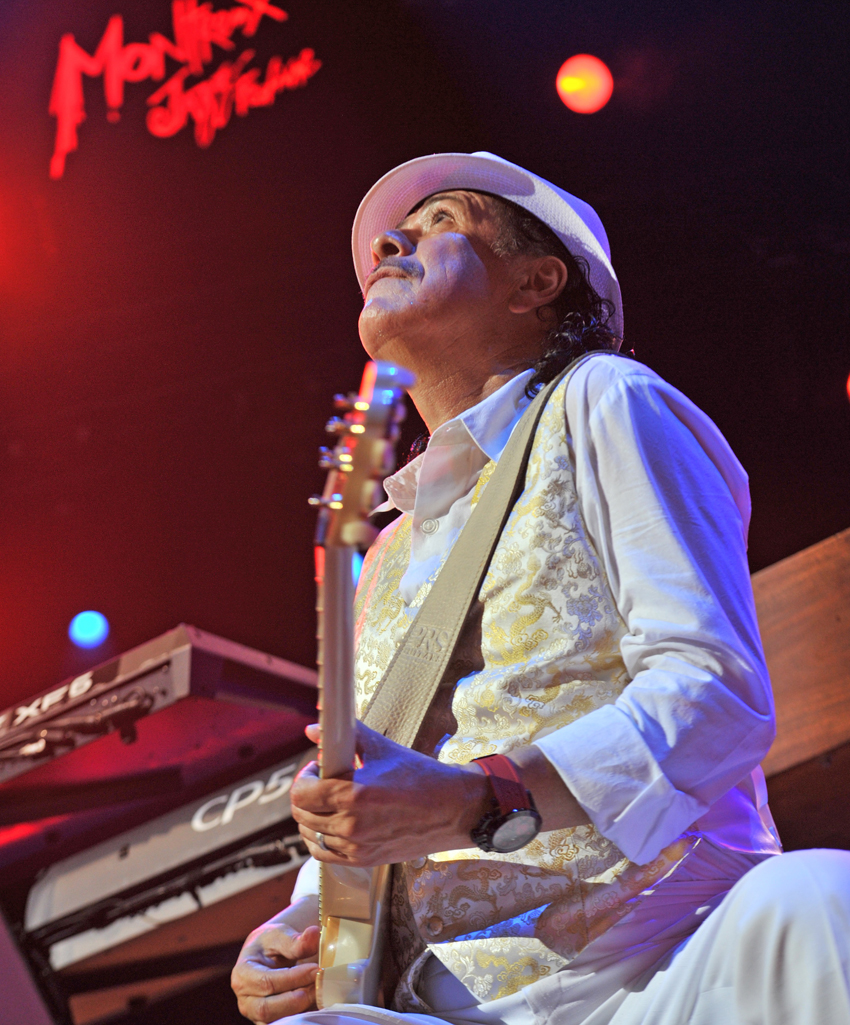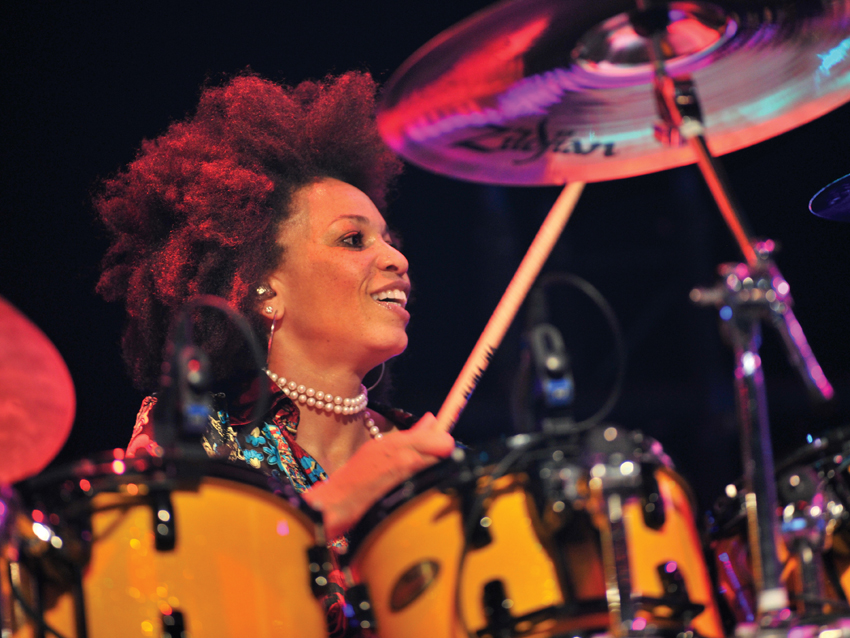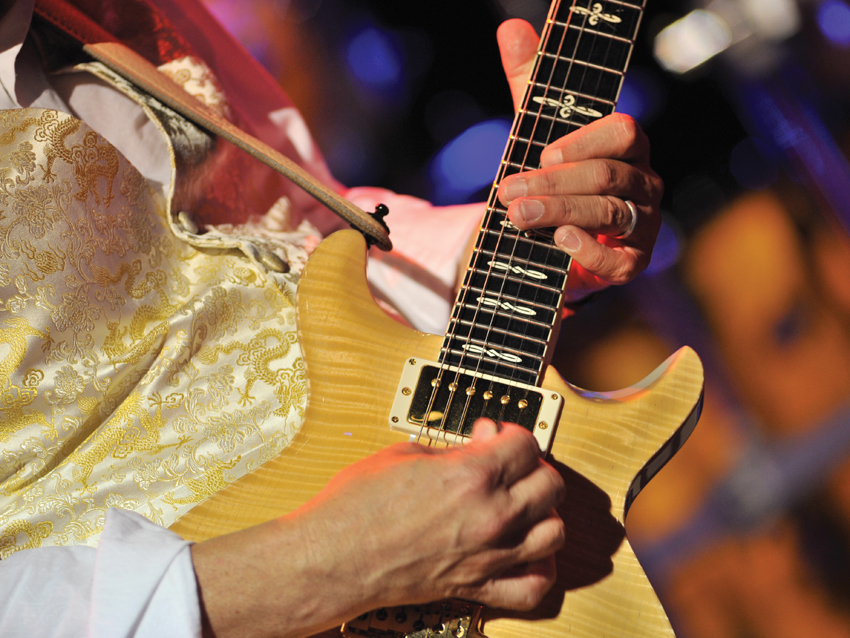
"When I do a show like this, I'm a chef," says Carlos Santana, describing the concert he and his band put on in July 2011, now documented on the upcoming Blu-ray and DVD release, Greatest Hits - Live At Montreux. "I have to make sure the temperature of everything is correct, that the ingredients and condiments and the essence are just right. The end result has to be supremely delicious.
"Music has to be the right tempo," he continues. "It has to have the right feel, the right groove, the right key…and then the elements, the garlic, the onions, the sauce...it all has to be fresh, genuine, true and for-freakin'-real!"
Santana's mouth-watering descriptions are certainly apt when one views the two-disc package, which offers up all of the guitarist's smash hits and a fascinating array of cover tunes, which run the gamut from John Coltrane to AC/DC. "Music is one of the biggest menus you could hope to choose from," says Santana. "When I pick songs from artists I love and revere, it can take a long time. But I'm looking at a great selection, a wonderful menu, so I'm sure my decisions will result in a fabulous meal."
With our stomachs growing, we sat down with Carlos Santana to talk about his new Blu-ray and DVD release, as well as his signature guitar tone, covering AC/DC and John Coltrane in the same set and whether he loves the guitar as much now as when he was a kid.
Carlos, your comparisons of music to food are incredible.
[laughs] "Well, sure! But why not? Whether it's food or sex, it has to be delicious. Music is like having that whipped cream on top of a wonderful dessert. Actually, it's more than that, because you have to have the whole menu. You need the salad, the appetizer, the soup, the main course and then the dessert. Good music isn't just a snack - it's the meal."
You recorded the new live set in Montreux. Your relationship with the city, and with Claude Nobs, the organizer, goes way back.
Get the MusicRadar Newsletter
Want all the hottest music and gear news, reviews, deals, features and more, direct to your inbox? Sign up here.
"That's right. We go back to 1970. I chose Montreux as the locale for the filming because Claude is more than just a promoter or impresario; he has the highest standards of anyone I know. He's like Bill Graham was - he really cares for the artist. He records his concerts with the utmost fidelity and definition. He's in his own league. And the Montreux audiences are great, very passionate and sophisticated."
Your signature guitar sound comes through beautifully on the live set. At this point, can you get your tone on any stage?
"Yes. No problem. I'll explain that: The most important thing one has to do to be supreme, whether you're playing Woodstock or a parking lot or the Grammys or Carnegie Hall, is you have to present…present with love. Your brain and your heart cannot be somewhere else.
"A real musician has to trust muscle memory; you have to know that your hands and fingers will go where they need to go. But at the same time, every note has to come from the center of your heart. There has to have a 'virgin-ness' to each note, as though it's the first time you've ever played it.
"My sound doesn't have anything to do with my sponsors. I say that with the utmost respect to those companies, the people who make the guitars and the amplifiers. They tell me the same thing: 'I'm glad you endorse our guitars, but you can get the Santana sound like Stevie Ray Vaughan with any guitar!'
"The sound has to come from you. But here's something you have to ask a musician: What were you thinking and feeling when you hit the note? Not what key it was or what chord, or what this or what that. Too many people think there's a secret formula to making music, like it's a gimmick or something. It's not! I could give you the same guitar and amplifier that Jimi Hendrix or Stevie Ray Vaughan used, and you won't sound like any of them. Only they could do that!"

Carlos pays his musical respects. © Edouard Curchod
On the subject of sound, you do a great version of Cream's Sunshine Of Your Love -
"Oh, thank you so much."
You and Eric Clapton share a similar kind of "woman tone." Is this something the two of you ever discussed?
"Eric is one of my best friends. He's my brother. We haven't really talked about that, no. I think it's because we both love Aretha and Billie Holiday. Sure, we love BB and Albert and Freddie and all the blues musicians, too. All of them sound like sassy women.
"A tenor saxophone is a male sound. A trumpet - Miles Davis - that's a female sound. So Eric's sound and my sound, those are female sounds. Stevie Ray, however, he had a male sound. It's just different overtones. Overtones are what give you one sound or the other."
But you and Eric have certainly sounded "male" - very aggressive, like Stevie Ray.
"That's true. I think you sound more male when you hit the lower, fatter strings. There's a difference between lamenting and whining. I'd rather lament. You know, like Eric, I love to express yearning."
Your version of Back In Black is killer. You recorded a studio version a couple of years ago with Nas. What attracted you to this song? Are you an AC/DC fan?
"Absolutely. I'm a big fan. The grooves that they put down are phenomenal. You know, a lot of what they do comes from Chuck Berry. He almost dances like Chuck Berry! [laughs] But his brother is the one, the rhythm guitarist, he's holding the whole thing together. To me, the rhythm guitar is the real muscle of any band.
"Don't get me wrong, I love playing lead, but rhythm is so important - it's the backbone. To be a really good guitarist, you have to know when to play lead and when to stick to rhythm."

Cindy Blackman-Santana behind the kit. © Edouard Curchod
During the Montreux set, you go from Evil Ways into John Coltrane's A Love Supreme.
"That's right. I thought they went together. When I go from Evil ways into A Love Supreme, it's like the way a dog shakes water. It's to shake fragments of fear and twist the thinking. There's a saying that goes, 'Simplicity is difficult for a twisted mind to understand.'
"For me to put Evil Ways together with Love Supreme, which to my mind no one has ever done before, I'm not desecrating either song. I'll take whatever I can take with respect and honor. It's not like I'm putting a moustache on the Mona Lisa. I'm telling the audience that anything they can claim about Santana, it's about you, it's about your own light."
Your wife, Cindy, is an amazing drummer, and she plays great with the band. What's it like performing with her?
"It's totally cool. We're always being accused of having sex on stage. It's like people are saying, 'You can't fool us. You two aren't playing music, you're having sex on stage.'" [laughs]
During the Montreux show, you bring out Derek Trucks and Susan Tedeschi. You've spoken quite highly of them in the past.
"I really love both of them. I don't mean this egotistically, but I'd like to be of service to them. I wish I could produce an album for them. Miles Davis used to say, 'Man, if you let me hang around Michael Bloomfield, I could bring something different out of him. I could bring some of that James Brown out of him.'
"A comfort zone isn't always a good thing for a musician. So, yeah, it's be great if I could bring some songs to Derek and Susan and have them say, 'Damn! How did Carlos know that he should bring this to us?' [laughs] This is the highest form of music, when you can give yourself chills because you've made the other person feel it."
How would you describe your relationship with the guitar? Is it the same as when you were a teenager, or has it changed over the years?
"It's the same feeling. It's like your first kiss and your first holding hands, your first eye to eye and your first penetration. It's that present with love. It's like what Wayne Shorter said to Wynton Marsalis: 'Notes are like people - you must listen to them.' When I pick up the guitar, I'm not practicing - I'm taking my fingers for a walk.
"Whether it's Otis Redding or Eric Clapton or Marvin Gaye…Michael Jackson or Miles Davis or Coltrane or Bob Marley…I take my fingers for a walk with them for about two, three hours. And when I come back, I don't even remember what I did or where I was - my fingers will."

Carlos takes his fingers "for a walk." © Edouard Curchod
So playing the guitar still transports you.
"Exactly! That's the word. That's the way to describe the best way you can play, whether you're Stevie Vai or Joe Satriani or John McLaughlin or whomever, you need to transport yourself to somewhere that is beyond the mechanics."
Beyond the new Blu-ray, what's up for you in 2012? Are you working on a new album?
"This is the best part of my life, because I finally realized that the best is not ahead, it's right now. There's more records or CDs to record, some with my own family, one just Latin… One thing coming up, though, is a record called Shape Shifter. I'll be putting it out in May. Aside from one song with vocals, it's all instrumental. It's not one of those guest-vocalist kinds of records. So people will get to hear Carlos Santana all by himself!
"The record is basically directed to honor the American Indians. As you know, the people in New Zealand collectively agreed to give an apology to the Aborigines in Australia, and for me, whatever we do here in America to honor the American Indians, the Chinese, African-Americans and everybody else is a big step. So I created a CD, Shape Shifter, and it's dedicated to the American Indians."
Well, we look forward to talking with you soon about that.
"That sounds good. And to you and everybody, make every day the best day of your life!"
Joe is a freelance journalist who has, over the past few decades, interviewed hundreds of guitarists for Guitar World, Guitar Player, MusicRadar and Classic Rock. He is also a former editor of Guitar World, contributing writer for Guitar Aficionado and VP of A&R for Island Records. He’s an enthusiastic guitarist, but he’s nowhere near the likes of the people he interviews. Surprisingly, his skills are more suited to the drums. If you need a drummer for your Beatles tribute band, look him up.










